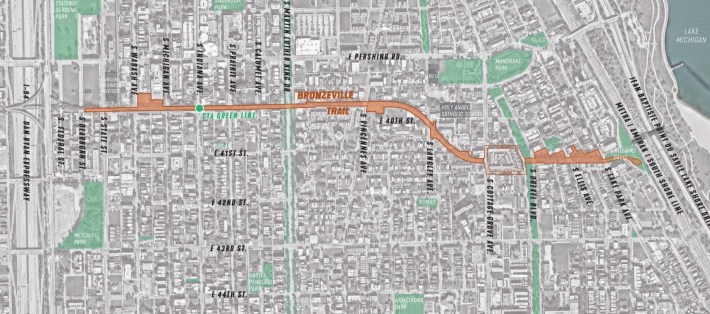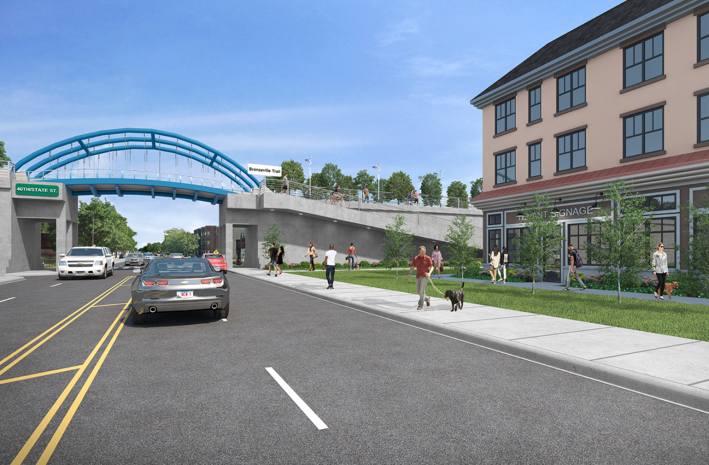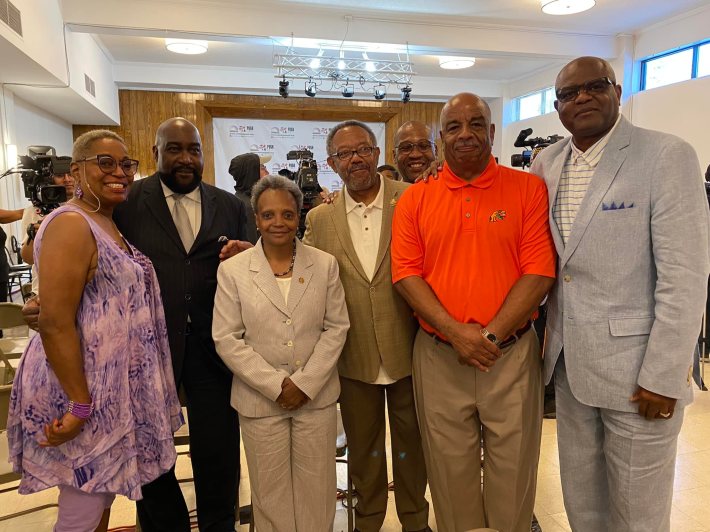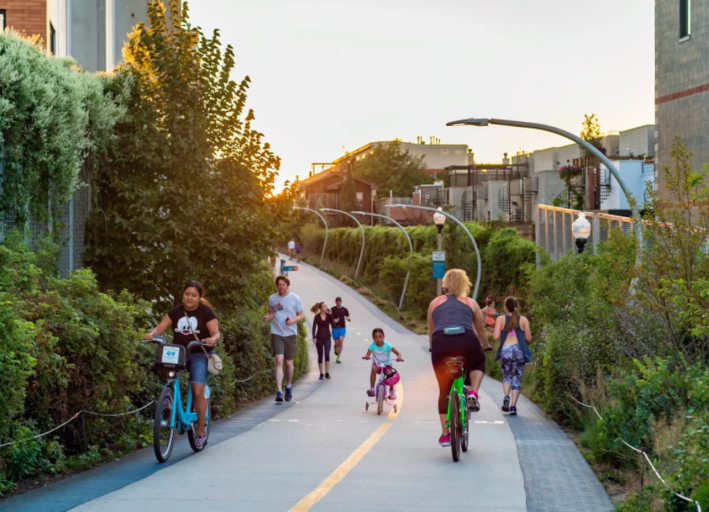For the past couple of years, the Bronzeville Trail Task Force has been working hard at converting the abandoned Kenwood 'L' line embankment, which was originally named the Stock Yard Line, into a walking, jogging, and biking path simply known as "the Trail." The elevated greenway would run about two miles between the western trailhead at 40th and Dearborn streets, and the eastern terminus at 41st Street and Lake Park Avenue. The route could also be extended to connected with the 41st Street bike-pedestrian bridge over DuSable Lake Shore Drive, providing safe access to the lakefront. The cost is estimated $100 million, comparable to the $95 million, 2.7-mile Bloomingdale Trail, aka The 606, which opened in 2015 on the Near Northwest Side.

The nonprofit was founded by John Adams, whose work on the project started in earnest during the COVID-19 lockdown. "At that point, I found myself with just some extra time on my hands, like a lot of people, working from home," Adams said. "I began to organize a talk to people about the potential of the project. And I have an extensive association/not-for-profit background personally. I'm the founder of the Chicago chapter of the National Association of Black Accountants. And I'm no longer there, but I'm formerly the CFO for the Rainbow Push Coalition and its three other affiliates."
From there, Adams built a board of three types of directors: residential stakeholders, institutional stakeholders, and legacy stakeholders. The latter were people who, like Adams, grew up in Bronzeville, were educated there, and who love the community, even though they may no longer live there. By September 2020, they had incorporated the Bronzeville Trail Task Force and applied for tax-exempt status.
The task force then spent most of 2020 organizing its board of directors. Among the members are Robert Young, CPA, the treasurer/secretary. Another is Walter Freeman, the board chair. The two of them live in Bronzeville, fairly close to the embankment they plan on developing. A third board member is Patricia Abrams, executive director of The Renaissance Collaborative, who approached the city with the same idea for the corridor back in 2005.

"We went as far as identifying the owners of the property, getting them to agree to deed the property over to us," Abrams stated in the task force's 2022 report. "We went to the city, but were told the liability would be too much, especially since it would entail walkways over streets in order for it to happen."
In February 2021, the advocates had their first conversation with an elected official, local alderperson Pat Dowell (3rd). They also checked in with Ald. Sophia King (40th), since the embankment runs through both wards. The two alders were very supportive of the project, according to the task force. It was Dowell who recommended that the advocates speak with Maurice D. Cox, commissioner of the Chicago Department of Planning. They had their first meeting with Cox in April of 2021 and their second that June. That was when they learned that the Cook County Land Bank, whose mission is to facilitate productive uses of disused properties, owned the corridor, which was instrumental in their next step.
"These rail to trail projects have proliferated all over the country for the last 30, 40 years, and usually the biggest obstacle is just getting title to the rail lines," said Adams. "Find out who owns the rail line and eventually getting the title to it. So in our case it really was a blessing that the embankment is owned by the Cook County Land Bank, a quasi-unit of government of Cook County. So at least we know who to negotiate with, who owns it, that sort of thing."
In July 2021, the Task Force put out a request for qualifications and identified the consultants it wanted to work with on the project. The board and the consultants took their first field trip to the corridor in September 2021. The advocates spent the remainder of the year focusing more on outreach to more elected officials, including Congressional rep Danny Davis.
On March 31, 2022, Mayor Lori Lightfoot announced a $15 million initiative to develop and improve 32 different trails in the Chicago area. The Bronzeville trail was among them. Then in April, the task force made its first public announcement about it mission on the website. "The mission of the Bronzeville Trail Task Force is to serve as the community stewards of the Bronzeville Trail, offering an independent voice while working closely with all stakeholders to ensure that the Trail is a vibrant, inclusive part of the Bronzeville Trail Community corridor."

Also on the website were the Task Force's goals:
• To sponsor and promote open communication on matters relating to the Bronzeville Trail with and between all communities, stakeholders, and users of the Trail.
• To advocate for, facilitate, and support opportunities for direct community engagement (e.g. arts, health, economic development, and inclusion) and to promote robust community involvement.
• To ensure a healthy balance between the Bronzeville Trail as a neighborhood amenity and a regional and international attraction.
• To investigate and preserve the history and life of the community adjacent to the Bronzeville Trail from the 19th century to the present.
• To assist in raising funds and securing resources to enhance the Bronzeville Trail.
• To apply to the Chicago Park District to be the official park advisory council for the Bronzeville Trail."
In April 2022, the task force received a $75,000 grant from the Chicago Community Trust charitable foundation (a Streetsblog Chicago funder) to use for conducting community outreach on the trail project.
According to Adams, "the city of Chicago decided that the first thing it wanted to do relative to the project was to conduct a feasibility study on the embankment. The successful bidder on that [$25,000] task order was the engineering firm T.Y. Lin International, and [in July 2022] we were part of the consulting team that won the bid."
The board also attended a Detroit symposium on trails, speaking with community activists and elected officials involved in Motor City bike-ped path development.
In summer 2022, the task force established the Bronzeville Trail History Project. "Our research began to tell the story of how rural African Americans, principally men who migrated from the south during the Great Migration, arrived in Chicago, and they already knew how to slaughter livestock," Adams said. "And they literally got on that same rail line, went into the Chicago Union Stockyards, and found employment on the spot in the stockyards. And so the purpose of the Bronzeville Trail History project is to tell the story through a Black lens about how African Americans played a significant role in Chicago becoming a meat-processing capital of the world."
September of 2022 was a busy month for the task force. First, the group hosted a minister's breakfast in Bronzeville. Then it held an event called Bronzeville Night Live, which included a female R&B group and a blues musician. The task force also held its their first "walk shop," where its members strolled the trail with community residents, discussing the trail plans and answering the questions.
In late December, T.Y. Lin finalized the task force's feasibility study. According to Adams, the next step will be a neighborhood development plan for Bronzeville, which the the advocates have been discussing with planning commissioner Cox. They'll also address some of the concerns people might have about the project, such as the question of how the new amenity might impact housing affordability. That has been a major issue with the Bloomingdale Trail, where the increased property values associated with trail proximity have also contributed to rising property taxes and rents.

Adams says trail-related housing displacement won't be an issue in Bronzeville like it has been along the Bloomingdale Trail, which was built in the already-gentrifying Wicker Park, Bucktown, Humboldt Park, and Logan Square communities. "Bronzeville is really different as a community, and here’s why," he said. "One is there’s a considerable amount of abandoned land in Bronzeville, so there’s a tremendous opportunity to develop that land."
Secondly, Adams said, "Bronzeville is already terribly expensive. So, it’s going to be difficult for one to make the argument that the trail is going to cause gentrification. That's, like, two decades too late. You can’t buy a townhome in Bronzeville for less than $700,000. Condos are $350,000 to $500,000. So it’s an entirely different economic base as this project gets started, than perhaps what was existing at the Bloomingdale Trail area."
Still, Adams said, measures are needed to ensure that all current Bronzeville residents can afford to stay in the neighborhood and benefit from the new trail. "We’re certainly concerned," he said. "In fact, one of the things that we think make a lot of sense is for more affordable housing in Bronzeville. So we’ll be a proponent of that. Now, the next steps are to address some of these concerns. In our conversations with Commissioner Maurice Cox, the very next step is a neighborhood development plan for Bronzeville."
While there are still many details to work out, it looks like Bronzeville Trail is well on its way to becoming a reality.

If you appreciate Streetsblog Chicago's livable streets movement coverage, please consider making a tax-deductible donation to help us raise $50K by 1/31 to fund our next year of reporting. Thanks!





